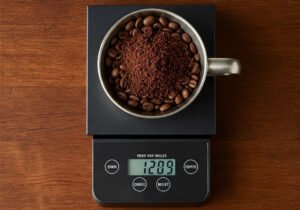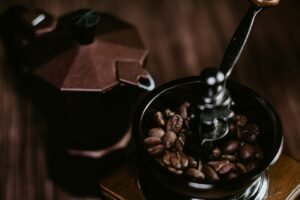Coffee—that magical elixir that powers millions through their day. Whether you’re a curious newcomer or looking to elevate your morning ritual, this comprehensive guide will take you from coffee novice to informed enthusiast. Let’s dive into the fascinating world of coffee beans, brewing methods, flavor profiles, and more.
The Origins: Where Your Coffee Comes From
Coffee beans aren’t actually beans at all—they’re seeds from cherry-like fruits that grow on coffee plants. These plants thrive in what’s known as the “Coffee Belt,” regions between the Tropics of Cancer and Capricorn where conditions are ideal for cultivation.
The two main commercial species are:
- Arabica: Grown at higher elevations, these beans offer complex flavors with bright acidity and are considered the higher quality option, accounting for about 60% of global production.
- Robusta: More disease-resistant with nearly double the caffeine content, robusta has a stronger, more bitter profile and is often used in espresso blends and instant coffee.
Coffee’s journey from plant to cup involves multiple stages: harvesting, processing (removing the fruit), drying, milling, grading, and finally roasting—where the magic truly happens.
Understanding Coffee Roasts
The roasting process transforms raw, grassy-smelling green beans into the aromatic coffee we know and love. Roast levels dramatically impact flavor:
- Light roasts (City, Half City, Cinnamon) preserve more of the bean’s original character with bright acidity and complex flavors. They contain slightly more caffeine and showcase fruity, floral notes.
- Medium roasts (American, Breakfast, City+) strike a balance between the bean’s original flavors and those developed during roasting. They offer a well-rounded taste with moderate acidity.
- Dark roasts (French, Italian, Vienna, Espresso) bring out rich, bold flavors with less acidity. The extended roasting develops caramelized sugars, creating chocolatey, nutty profiles sometimes with smoky undertones.
Understanding roast preferences is key to finding coffees you’ll enjoy. Many specialty coffee shops list roast levels on their packaging.
Brewing Basics: Methods and Equipment
The brewing method you choose significantly impacts your coffee experience. Here are the most popular approaches:
Pour-Over: This manual method involves pouring hot water over ground coffee in a filter. It offers exceptional clarity of flavor and highlights the bean’s nuances. Equipment needed includes a pour-over dripper (like Hario V60, Chemex, or Kalita Wave), filters, and a gooseneck kettle for precision pouring.
French Press: This immersion method steeps coffee grounds directly in hot water before filtering them with a metal mesh plunger. The result is a full-bodied cup with rich mouthfeel. Simple and forgiving for beginners.
Espresso: High-pressure extraction creates concentrated coffee that serves as the foundation for many cafe drinks. Home espresso machines range from affordable manual options to sophisticated automatic models.
Automatic Drip: The convenience champion, these machines handle water temperature and flow rate, making morning coffee effortless.
Cold Brew: Steeping coarsely ground coffee in cold water for 12-24 hours produces a smooth, low-acid concentrate that can be diluted and served over ice.
Perfect Your Grind: The Unsung Hero
Grinding matters tremendously. Coffee begins losing flavor within minutes of grinding as compounds oxidize. Investing in a quality burr grinder might be the single most impactful upgrade for your coffee routine.
Different brewing methods require different grind sizes:
- Coarse (French press, cold brew)
- Medium-coarse (clever dripper, Chemex)
- Medium (drip coffee makers)
- Medium-fine (pour-over methods like V60)
- Fine (espresso, Moka pot)
- Extra-fine (Turkish coffee)
Pre-ground coffee offers convenience but sacrifices freshness and customization.
The Perfect Cup: Variables to Control
Great coffee comes down to consistency in these key variables:
- Coffee-to-water ratio: A good starting point is 1:16 (about 15g coffee per 240ml water)
- Water temperature: Ideally 195-205°F (90-96°C)
- Extraction time: Varies by method (30 seconds for espresso, 3-4 minutes for pour-over)
- Water quality: Use filtered water free of strong odors or flavors
Must-Have Coffee Gear for Beginners
Affiliate Link Opportunities:
- Entry-level burr grinder

- Digital kitchen scale with 0.1g precision
- Electric gooseneck kettle with temperature control
- French press
- Pour-over starter kit
- Airtight coffee storage container
- Milk frother for homemade lattes
- Reusable travel mug for sustainable coffee on the go
- Espresso starter machine (Breville Bambino or Flair Neo)
Coffee Flavor Profiles: Developing Your Palate
Coffee’s flavor wheel includes notes ranging from fruity (berries, citrus, stone fruit) to nutty, chocolatey, floral, spicy, and earthy. These flavors come from the bean’s variety, growing conditions, processing method, and roasting approach.
When tasting coffee, notice:
- Acidity: The bright, tangy quality (not sourness)
- Body: The weight and texture in your mouth
- Sweetness: Natural sugars developed during roasting
- Finish: Lingering flavors after swallowing
Try coffees from different regions to explore the spectrum:
- Ethiopia: Bright, fruity, floral, and tea-like
- Colombia: Well-balanced with caramel sweetness
- Brazil: Low acidity, nutty, chocolatey
- Guatemala: Rich, complex with chocolate and spice notes
- Sumatra: Earthy, herbal, full-bodied
Coffee’s Nutritional Profile
In its pure form, black coffee is a low-calorie beverage packed with beneficial compounds:
- A standard 8oz cup contains just 2-5 calories
- Coffee delivers antioxidants including chlorogenic acids and melanoidins
- Contains small amounts of B vitamins, magnesium, and potassium
- A typical cup provides 80-100mg of caffeine (varies by bean and brewing method)
Research suggests moderate coffee consumption (3-5 cups daily) may contribute to:
- Improved cognitive function
- Enhanced athletic performance
- Reduced risk of certain conditions including Parkinson’s disease, type 2 diabetes, and liver disease
Nutrition changes dramatically with additions:
- 1 tablespoon of cream adds 50 calories
- 1 tablespoon of sugar adds 48 calories
- Specialty cafe drinks can contain 250-500+ calories
For those monitoring intake, consider:
- Using cinnamon instead of sugar for sweetness
- Trying unsweetened nut milks for creaminess
- Gradually reducing sweetener to appreciate coffee’s natural flavors
Common Mistakes to Avoid
Even simple adjustments can dramatically improve your coffee experience:
- Using old beans: Coffee is best consumed within 2-4 weeks of roasting
- Storing improperly: Keep beans in an airtight container away from heat, light, and moisture
- Using water that’s too hot: Boiling water (212°F/100°C) can scorch grounds
- Inconsistent measurements: “Eyeballing” leads to inconsistent results
- Buying pre-ground coffee: Grinding fresh preserves flavors and aromas
Ethical Coffee: Understanding Certifications
As you explore coffee, consider these common certifications:
- Fair Trade: Ensures farmers receive fair compensation
- Organic: Grown without synthetic pesticides or fertilizers
- Rainforest Alliance: Focuses on environmental and social standards
- Direct Trade: Roasters work directly with farmers, often paying premium prices
- Bird Friendly: Shade-grown to preserve bird habitats
Conclusion: Your Coffee Journey Begins
Coffee exploration is a rewarding lifelong adventure. Start with quality beans, invest in basic equipment, and experiment with different origins and brewing methods. Take notes on what you enjoy, and don’t be afraid to ask questions at local coffee shops—baristas are usually passionate about sharing knowledge.
Remember that “good coffee” is ultimately what tastes good to you. Trust your palate, and enjoy the process of discovery as you develop your own perfect cup.
This post may contain affiliate links. If you make a purchase through these links, I may earn a small commission at no extra cost to you.




